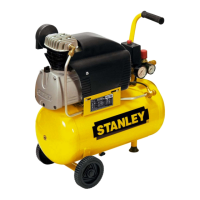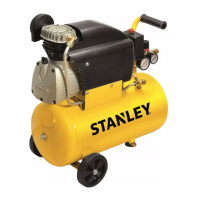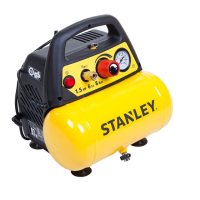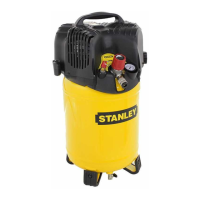G
B
16
residualcurrentdevice(R.C.D.)atthesocketoutlet.
Note: If the mains cable requires replacing it must be replaced with an
identicaloneandfittedbyaqualifiedperson.
START-UP AND USE
4
•Check for correspondence between the compressor plate data with the
actual specifications of the electrical system.Avariation of ± 10% with
respectoftheratedvalueisallowed.
•Inserttheplugofthepowercableinasuitablesocket(fig. 6)checkingthat
the button of the pressure switch located on the compressor is in the OFF
«O»position.
•Check the oil level by meansoftheoil dipstick (figures 7a- 7b), and if
necessarytopup.
•Atthispoint,thecompressorisreadyforuse.
•Operating on the switch of thepressureswitch (fig. 1), the compressor
starts,pumpingairintothereceiverthroughthedeliverypipe.
•When the upper calibration value (set by the manufacturer) has been
reached,thecompressorstops,ventingtheexcessairpresentinthehead
andinthedeliverypipethroughavalvelocatedunderthepressureswitch.
This facilitates subsequent restart due to the absence of pressure in the
head.Whenairisused,thecompressorrestartsautomaticallywhenthe
lowercalibrationvalueisreached(2barbetweenupperandlower).
•Thepressureinthereceivercanbecheckedonthegaugeprovided(fig. 8).
•The compressor continues to operate according to this automatic cycle
untiltheswitchofthepressureswitchisturned.
•Always wait at least 10 seconds from when the compressor has been
switchedoffbeforerestartingthis.
•All compressors are fitted with a pressure reducer. Operating on the
knobwiththetapopen(turningitinaclockwisedirectiontoincreasethe
pressure and in a counterclockwise direction to reduce this, fig. 9a),air
pressurecanberegulatedsoastooptimizeuseofpneumatictools.After
settingthe value required,thering-nutunderneathmust be tightenedto
fastentheknob(fig. 9b).
•Thevaluesetcanbecheckedonthegauge.
•Please check that the air consumption and the maximum working
pressure of the pneumatic tool to be used are compatible with the
pressure set on the pressure regulator and with the amount of air
supplied by the compressor.
•Always pull out the plug and drain the receiver once you have completed
yourwork(figures 10-11).
MAINTENANCE
5
•BEFORE CARRYING OUT ANY OPERATION, ALWAYS PULL OUT THE
PLUG AND DRAIN THE RECEIVER COMPLETELY (figures 10-11).
•Checkthatallscrews(inparticularthoseoftheheadoftheunit)aretightly
drawnup(torque10Nm=1.02Kgm).
Thecontrolmustbeperformedbeforethefirststart-upofthecompressor
and subsequently before the first intensive use in order to restore the
correctclosingtorquevaluemodifiedasaresultofheatexpansion.
•After loosening any safety screws, clean the intake filter according to
the type of working environment and at least every 100 hours (figure
12).Ifnecessary,replacethefilterelement(cloggingofthefilterreduces
compressorperformanceandaninefficientfiltercausesincreasedwear).
•Replace the oil after the first 100 hours of operation and every 300 hours
subsequently(figures 13a-13b-13c).Remembertochecktheoillevelat
regularintervals.
Use SAE 40.(For cold climates, SAE 20 is recommended). Never mix
differentgradeoils.Iftheoilchangescolor(whitish=presenceofwater;
dark=overheated),itisgoodpracticetoreplacetheoilimmediately.
•Periodically(orafterworkingwiththecompressorformorethananhour),
drainthe condensate that forms insidethe receiver (fig. 11)due to the
humidityintheair.Thisprotectsthereceiverfromcorrosionanddoesnot
restrictitscapacity.
•Spent oil (lubricated models) and condensate MUST BE DISPOSED
OF in accordance with environmental protection regulations and current
legislation.
The compressor must be disposed in conformity with the methods
provided for by local regulations.
TABLE 1 – MAINTENANCE
FUNCTION
AFTER THE
FIRST 100
HOURS
EVERY 100
HOURS
EVERY 300
HOURS
Cleaning of intake filter and/
or substitution of filtering
element
●
Change of oil
● ●
Tightening of head tension
rods
Atstart-upandafterthefirsthourofwork
Draining tank condensate Periodically and at the end of work
POSSIBLE FAULTS AND RELATED PERMITTED REMEDIES
6
FAULT CAUSE REMEDY
Leakage of air from the valve of the pressure
switchwiththecompressoroff.
Check valve that, due to wear or dirt on the seal,
doesnotperformitsfunctioncorrectly.
Unscrewthehexagonalheadofthecheck
valve, clean the valve seat and the special
rubberdisk(replaceifworn).Reassembleand
tightencarefully(gures14a-14b).
Reductionofperformance.Frequentstart-up.
Lowpressurevalues.
Excessiveperformancerequest,checkforany
leaksfromthecouplingsand/orpipes.Intake
ltermaybeclogged.
Replacethesealsofthetting,cleanorreplace
thelter.
The compressor stops and restarts
automaticallyafterafewminutes.
Tripping of the thermal cutout due to
overheatingofthemotor.
Cleantheairductsintheconveyor.Ventilate
theworkarea.Resetthethermalcutout.On
lubricated type models, check oil level and
quality.
After a few attempts to restart, the compressor
stops.
Tripping of the thermal cutout due to
overheatingofthemotor(removalofthe
plug with the compressor running, low power
voltage).
Activatetheon/offswitch.Ventilatethework
area.Waitafewminutes.Thecompressorwill
restartindependently.Removeanypowercable
extensions.
The compressor does not stop and the safety
valveistripped.
Irregular functioning of the compressor or
breakageofthepressureswitch.
Remove the plug and contact the Service
Center.
AnyothertypeofoperationmustbecarriedoutbyauthorizedServiceCenters,requestingoriginalparts.Tamperingwiththemachinemayimpairitssafety
andinanycasemakethewarrantynullandvoid.
Warranty and repair.
Intheeventofdefectivegoodsorrequirementsforspareparts,kindlycontactthesalespointwhereyoumadeyourpurchase.

